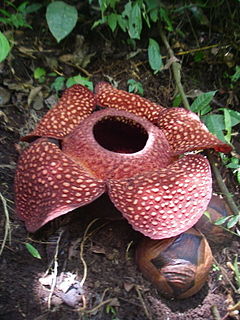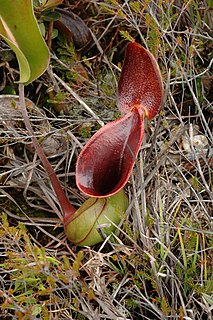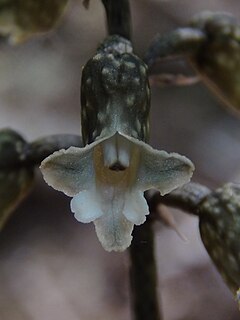
Rafflesia is a genus of parasitic flowering plants in the family Rafflesiaceae. The species have enormous flowers, the buds rising from the ground or directly from the lower stems of their host plants; one species has the largest flowers in the world. The genus contains approximately 28 species, all found in Southeast Asia, mainly in Indonesia, Malaysia, Thailand and the Philippines. For Western Europe, it was first discovered by French surgeon and naturalist Louis Deschamps in Java between 1791 and 1794, but his notes and illustrations, seized by the British in 1803, were not available to western science until 1861. The first British person to see one was Joseph Arnold in 1818, in the Indonesia rainforest in Bengkulu, Sumatra, after a Malay servant working for him discovered a flower and pointed it out to him. It was later named after Stamford Raffles, the leader of the expedition.

Nephelaphyllum is a genus with 12 species of orchids. Its genus is distributed in southern China, the Himalayas, Indochina, Indonesia, Malaysia and the Philippines.

Nepenthes villosa, or the villose pitcher-plant, is a tropical pitcher plant endemic to Mount Kinabalu and neighbouring Mount Tambuyukon in northeastern Borneo. It grows at higher elevations than any other Bornean Nepenthes species, occurring at elevations of over 3,200 m (10,500 ft). Nepenthes villosa is characterised by its highly developed and intricate peristome, which distinguishes it from the closely related N. edwardsiana and N. macrophylla.

Nepenthes burbidgeae, also known as the painted pitcher plant or Burbidge's Pitcher-Plant, is a tropical pitcher plant with a patchy distribution around Mount Kinabalu and neighbouring Mount Tambuyukon in Sabah, Borneo.

Nepenthes reinwardtiana is a tropical pitcher plant native to Borneo and Sumatra and to a number of smaller surrounding islands including Bangka, Natuna, Nias, and Siberut. Although some sources have included Peninsular Malaysia and Singapore within the range of this species, these records appear to be erroneous.

Nepenthes spathulata is a tropical pitcher plant native to Java and Sumatra, where it grows at elevations of between 1100 and 2900 m above sea level. The specific epithet spathulata is derived from the Latin word spathulatus, meaning "spatula shaped", and refers to the shape of the lamina.

Nepenthes lowii, or Low's pitcher-plant, is a tropical pitcher plant endemic to Borneo. It is named after Hugh Low, who discovered it on Mount Kinabalu. This species is perhaps the most unusual in the genus, being characterised by its strongly constricted upper pitchers, which bear a greatly reduced peristome and a reflexed lid with numerous bristles on its lower surface.

Nepenthes stenophylla, or the narrow-leaved pitcher-plant, is a tropical pitcher plant endemic to Borneo. The species produces attractive funnel-shaped pitchers up to 25 cm high. It is listed as Least Concern on the IUCN Red List. Nepenthes stenophylla belongs to the loosely defined "N. maxima complex", which also includes, among other species, N. boschiana, N. chaniana, N. epiphytica, N. eymae, N. faizaliana, N. fusca, N. klossii, N. maxima, N. platychila, and N. vogelii.

Nepenthes campanulata, the bell-shaped pitcher-plant, is a tropical pitcher plant native to Borneo. It has also been reported from Palawan, the Philippines, though further field work is needed to confirm this identification.

Nepenthes singalana is a tropical pitcher plant endemic to the island of Sumatra, where it grows at 2000–2900 m above sea level. It is most closely allied to N. diatas and N. spathulata.

Gastrodia, commonly known as potato orchids or as 天麻属 , is a genus of terrestrial leafless orchids in the family Orchidaceae, about ninety of which have been described. Orchids in this genus have fleshy, upright stems and small to medium-sized resupinate flowers with narrow sepals and petals. They are native to Asia, Australia, New Zealand, central Africa, and various islands of the Indian and Pacific Oceans.

Vrydagzynea, commonly called tonsil orchids, is a genus of orchids in the tribe Cranichideae. About forty five species of Vrydagzynea have been formally described. They are native to India, Taiwan, Southeast Asia, Malesia, Melanesia and Polynesia. A single species in Australia is possibly extinct. They have thinly textured, stalked leaves and small, dull-coloured resupinate flowers with the dorsal sepal and petals overlapping to form a hood over the column.
Porrorhachis is a genus of flowering plants from the orchid family, Orchidaceae. It contains two known species, both native to Southeast Asia.

Pteroceras is a genus of flowering plants from the orchid family, Orchidaceae. It is native to China, the Indian Subcontinent, and Southeast Asia.

Sciaphila is a genus of mycoheterotrophic plants in the family Triuridaceae. These plants receive nutrition from fungi and neighboring trees and have less need for photosynthesis. It is widespread in tropical and subtropical regions, found in Africa, China, Japan, the Indian Subcontinent, Southeast Asia, Latin America and on various islands Pacific Islands.
Gastrodia kuroshimensis is an unusual species of plant that was discovered in April 2016. It is mycoheterotrophic, meaning that it does not engage in photosynthesis like most plants but obtains energy from its host fungi. It is also cleistogamous, meaning that it produces flowers that never open. Since its flowers never open, it is self-fertilizing.

Gastrodia cooperae, also known as Cooper's black potato orchid, is a species of plant in the family Orchidaceae and is endemic to New Zealand. The specific epithet cooperae refers to Dorothy A. Cooper, founder of the New Zealand Native Orchid Group.
Gastrodia gunatillekeorum is a new species of potato orchid discovered in Sinharaja rainforest and described in 2020. Each with less 100 mature individuals, only three small populations have been discovered as yet. This plant was named after Nimal Gunatilleke and Savithri Gunatilleke.
Gastrodia zeylanica is a species of potato orchids which is endemic to Sri Lanka. It was added to the 2007 Red list of Threatened Fauna and Flora of Sri Lanka as 'critically endangered', on the basis of it having only been collected from a few localities.














